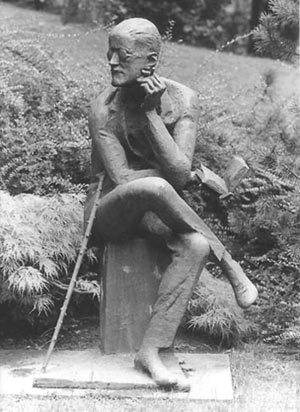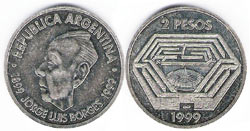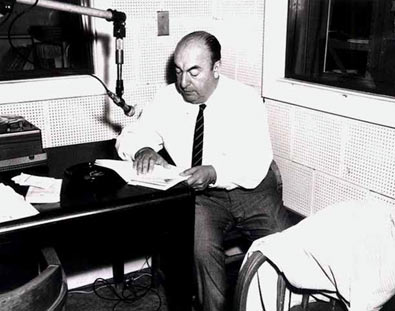|
Fuentes's
novel The Death of Artemio Cruz in language, style and
in structure borrows from Joyce's innovations in prose, and
the Vicoesque, circular sense of history, and deriving from
this, from Joyce's study of Vico. [19] Joyce's shorter works,
the fiction he wrote with astonishing grace and technical
precision, Dubliners, exerted an influence on Carlos
Fuentes's novel Distant Relations, and his short
stories from the text Burnt Water. A number of critics
have noted that Fuentes's short stories are his achievement,
not the novels, yet Joyce's influence on both is apparent in
Fuentes's attempts to capture the essence of Mexico City in
shorter works. Like
Joyce, Fuentes experiments with language,
time and voice, and with the employ of differing points
of view in one text. [20]
|

Life-size bronze of James
Joyce
in Zurich's Fluntern Friedhof
(Milton Hebald, 1966)
|
James
Joyce's use of language, his playfulness with English, has
been mimicked by Carlos Fuentes in Spanish. From his first
novel Where the Air is Clear to his last epic novel
The Years with Laura Diaz, Fuentes uses calembours
and portmanteau words, (palabras compuestas) engaging the
reader - as he does throughout Christopher Unborn - in
word association games, embedding historical events in
sentences pages long, capturing and describing continuous
thought, while also working in vivid descriptions, ideas that
congeal into a plot, and interior monologues that play out
entire personal histories (see especially The Death of
Artemio Cruz).
What Joyce
biographer Richard Ellmann describes of Joyce in
his monumental biography is apt to Fuentes: 'Joyce was as
local and as scrupulous in vision as Dante but he put aside Dante's heaven
and hell, sin and punishment, preferring like Balzac to keep
his comedy human, and he relished secular, disorderly lives
which Dante would have punished or ignored' (4, James Joyce).
[21] Argentine author Julio Cortázar, another author who is
very heavily influenced by Joyce, so much so that he was
criticised as being afflicted with 'Ulyssomania', wrote that
Fuentes's first novel was a 'comedia humana', magical and
metaphysical, achieving with language what Ulysses
achieved. However, Cortázar ascribes to the Irish writer 'más
fines literarios'. Fuentes's book,
for Latin America, in contrast, is a beginning. Cortázar
continues: 'Joyce puts the accent on technique with the
intention of rupturing traditional models or moulds of writing
the novel.' [22]
Fuentes's
novels run a range from the comical to the tragic,
but they are notable for the choice of depicting commonplace
and middle-class Mexico. In many instances, the figures he
depicts are images raised in artistic relief against the
foundation myths of Mexican
culture. Fuentes also criticises Mexico,
its economic and social disparities, its reliance on the
United States for so many essential things, its failure to
acknowledge positive influences that other cultures have
brought to education, law, language - even cuisine. [23]
|

Argentine Two Pesos
coin
in memoriam of Jorge Luis Borges
|
Both Joyce
and Fuentes offer an artistic portrayal, imagined visions of
Dublin and of Mexico City. While Fuentes's works also
illustrate an opinion pointedly critical of the upper classes
and their yearning for North American values, Joyce's works
examine the emerging identity of Irish people in the modern
world. If Joyce's works can be compared to the modernist style
of painting, Cubism, which Pablo Picasso and Georges Braque so
creatively and vigorously pioneered in drawing, painting, and
in sculpture, then Fuentes's early works are aptly compared to
the new style of painting of the Mexican student of Picasso's
cubist works, muralist Diego Rivera. Pablo Neruda, James
Joyce, and Carlos Fuentes share this blurring of artistic
visions and artistic merging of styles, genres and fora for
expressing the inexpressible. [24]
Fuentes's
first novel, La Región Más Transparente (Where the Air
is Clear) confirms the impressions Joyce's works had already
made on the young Fuentes, and on Fuentes's use and
manipulation of language. It is as if Fuentes has declared 'I
can do anything with the Spanish language.' In his novels,
Fuentes uses poetic chiasmic structures, anaphora, and long
prose-poem descriptions to introduce chapters. Fuentes,
borrowing from Joyce's Hiberno-English marks the greatest literary borrowing
that
changed the novel and literature in Spanish; notably, this
borrowing occurs
between two (self-imposed) exiles.
Another of
Fuente's massive and comprehensive works, Terra Nostra
is placed by critic Gerald Martin among the seminal
Ulyssean works. If Fuentes's first novel, Where the Air
is Clear, speaks with Joycean language, then Terra
Nostra continues to grapple, after The Death of Artemio
Cruz and A Change of Skin, with the linguistic
challenges Fuentes faced in creating a Ulyssean novel. Martin
states that the novel Terra Nostra was a 'monumental
attempt to review the whole psychological and political
history of Spain and Spanish America [and that] its relative
failure ... marks the impossibility after the late 1960s to
write Ulyssean novels based on coherent historical cycles,
epiphanic insights and optimistic conclusions.' [25] So, as
with all protean authors, Fuentes changed the shape of the
Latin American novel and wrote Cristóbal Nonato (1987),
a Finnegan's Wake-influenced novel that, along with
Mario Vargas Llosa's Aunt Julia and the Scriptwriter
(1977) and Guillermo Cabrera Infante's Three Trapped Tigers
(1967) (Cuban, another bilingual who read Joyce in
English), celebrate laughter in the Latin American novel.
For
Fuentes, Borges, and
Neruda the English language, like French for T.S. Eliot and for
Beckett, was a beacon, a way to change Spanish. Joyce's two
monumental novels, Ulysses and Finnegans Wake,
provide the poetic prose model that the writers from the
Americas would use for their own literary projects. Even
writers who did not know English as well as the bilinguals,
and writers who did not know English at all, chose
Portrait of the Artist as a Young Man and Ulysses -
and fewer, but still some, Finnegans Wake - as examples
to mimic and from which to borrow, and to learn how to
modernise the Spanish language.
[26]
In their poetry,
essays, short stories, and novels, throughout the twentieth century in
Spanish, and sometimes in English, Latin American authors have
found in Joyce's works complements, guides and literary
signals to their own inventions. The Boom writers and those
poets who were beacons in changing the language looked to
James Joyce when carrying out their own projects, sometimes in
silence, many in exile and most with cunning. [27]
When asked
if there is a shared attitude Latin American authors have
toward the Spanish language, Fuentes's reply is instructive
about Joyce's influence in their forming a critical attitude
toward that language: 'We [the Boom writers] had the sensation
that we had to invent the language, that we had to fight with
the canons of the language, that it is false to believe that
an established Spanish language exists ... Joyce had the
same attitude toward English.' [28]
David Vela
* Past
President of the Irish Literary & Historical Society, San
Francisco, California. Instructor of English, Diablo Valley
College, California, USA. |



